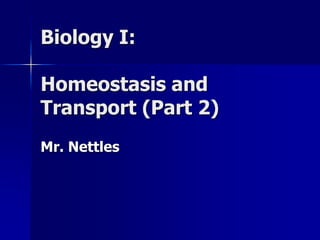
Homeostasis and transport (part 2)
- 1. Biology I: Homeostasis and Transport (Part 2) Mr. Nettles
- 2. Agenda – Wed., Sept. 14, 2011 Warm-Up (3 min) Today’s Objectives (2 min) Lesson (40 min) Wrap-Up (5 min)
- 3. Warm-Up 1. When both sides of a concentration gradient have an equal concentration of molecules on each side ______________ has been reached. 2. _________________involves the use a protein carrier to move molecules from an area of higher concentration to an area of lower concentration. a) osmosis, b) diffusion, c) facilitated diffusion, d) active transport 3. In your own words, define homeostasis. (1 point Bonus!!) Explain an example related to the human body.
- 4. Warm-Up 1. When both sides of a concentration gradient have an equal concentration of molecules on each side __equilibrium__ has been reached. 2. _________________involves the use a protein carrier to move molecules from an area of higher concentration to an area of lower concentration. a) osmosis, b) diffusion, c) facilitated diffusion, d) active transport 3. In your own words, define homeostasis. (1 point Bonus!!) Explain an example related to the human body. - the ability to maintain a stable internal (inside) environment - People sweat to keep from overheating while exercising
- 5. Today’s Objectives I will describe three types of passive transport. – Osmosis, Diffusion, Facilitated Diffusion I will articulate one example of active transport I will define: solvent, solute, solution, hypertonic, hypotonic, and isotonic.
- 6. Think!! If the molecules can’t get through the membrane, how else could it become less crowded?
- 7. Osmosis Osmosis: WATER moves across a membrane to create more space. Osmosis always moves water toward the side that has MORE molecules Osmosis does NOT need energy.
- 8. Osmosis Osmosis moves WATER from higher concentration [OF WATER] to lower concentration [OF WATER]. – Moves from more water to less water
- 9. Hypertonic vs. Hypotonic Key Vocabulary Solute = what is being dissolved (salt, Koolaid, other molecules) Solvent = what molecules are dissolved in (water or other liquid) Solution = an even mixture of solute and solvent (Koolaid drink) Hypertonic = high concentration of solute, low concentration of solvent Isotonic = equal concentration of solute and solvent Hypotonic = low concentration of solute, high concentration of solvent
- 10. Hypertonic vs. Hypotonic If you place a normal cell in a hypertonic solution, water will flow _?_ of the cell If you place a normal cell in a hypotonic solution, water will flow _?_ the cell
- 12. Hypertonic vs. Hypotonic If you place a normal cell in a hypertonic solution, water will flow OUT of the cell If you place a normal cell in a hypotonic solution, water will flow INTO the cell
- 13. If water moves INTO a cell, the cell gets bigger = swells, expands, grows - (Hypotonic solution) If water moves OUT OF a cell, the cell gets smaller = shrinks - (Hypertonic solution)
- 14. Active Transport Using energyto move materials in and out of the cell is called active transport. Molecules move from areas of low concentration to areas of high concentration. – Move from less crowded to more crowded
- 15. Active Transport: Example: Na2+/K+ Pump Sodium-Potassium Pump moves sodium out of the cell and potassium into the cell using energy. Important for electric signal between neurons.
- 16. Moving Across a Membrane Steps to tell what kind of transport: 1. Ask: what moves? – If molecules move , it is Diffusion. – If water moves, it is Osmosis.
- 17. Moving across a membrane 2. Which way do the molecules move? – If molecules move from higher concentration to lower concentration, it is diffusion – If molecules move from lower concentration to higher concentration, it is active transport.
- 18. Moving Across a Membrane Osmosis Diffusion Active What moves Energy Toward which side? Example
- 19. Moving Across a Membrane Osmosis Diffusion Active What Water Molecules Molecules moves Energy Toward which side? Example
- 20. Moving Across a Membrane Osmosis Diffusion Active What Water Molecules Molecules moves Energy No No Yes Toward which side? Example
- 21. Moving Across a Membrane Osmosis Diffusion Active What Water Molecules Molecules moves Energy No No Yes Toward Water moves Molecules Molecules to the side with move to less move to more which more concentrated concentrated side? molecules side side Example
- 22. Moving Across a Membrane Osmosis Diffusion Active What Water Molecules Molecules moves Energy No No Yes Toward Water moves Molecules Molecules to the side with move to less move to more which more concentrated concentrated side? molecules side side Cell in a Smell of Example hypertonic perfume Na++/K+ pump solution
- 23. Wrap-Up If a cell that contains a 10% salt solution is placed in a 90% salt solution, will water flow into or out of the cell? Is the cell hypertonic or hypotonic? Identify the description as osmosis, diffusion, or active transport? 1. Water moves into a cell from high concentration to low concentration 2. Iodine molecules move into a cell from high concentration to low concentration 3. Sodium molecules are moved from a low concentration to a high concentration
